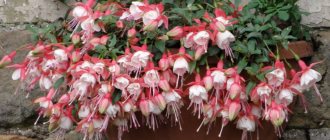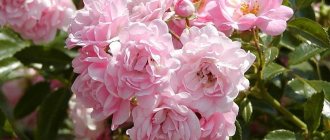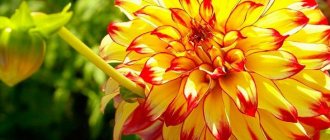Previously known to everyone exclusively as a wildflower, cornflower subsequently took on a cultivated form and settled in many flower beds as an ornamental plant. And its various varieties today boast more than just shades of blue.
Garden cornflowers have one difference visible to the naked eye from meadow plants of this species: they are decorative and are distinguished by larger flowers. And most importantly: the rich blue shade of the buds, which is familiar to us, has been replaced by a variety of colors of cultivated species and varieties. By the way, among the inhabitants of flower beds there are also cornflowers, which are radically different from the original even in the appearance of the flowers: they are denser and fluffier, and we will also tell you about them.
There are two versions of the origin of the word centaurea - the Latin name of the plant. One of them, mythological, claims that with the help of cornflower the centaur Chiron was healed from the poison of the Lernaean Hydra. Another says that this flower was called that way even under Hippocrates, and translated from Greek its name literally sounds like “stabbing bulls.”
Classic Fantastic
An annual or biennial flower in cool blue shades, from light sky and blue to dark blue, as well as two-tone blue and white. Grows up to 100 cm in height and up to 30 cm in width. Unpretentious to grow. Looks especially good in borders and as part of a Moorish lawn. Flowering is abundant and long lasting - from June until frost.
- Low-growing plants for hedges and borders
Emphasize the beauty of the landscape with a low hedge up to 1 m high.
Cornflower petals of some varieties (for example, Classic Fantastic) are used in cooking - added to salads, sprinkled on omelette or pasta.
John Coutts
Large pink or purple flower with a white center. Capable of growing up to 50 cm in height and width. The plant is rich in pollen, so it performs an additional function by attracting living helpers - bees - to your site. Perennial, frost hardy, ideal for mixed herbaceous borders, gardens or containers where it will bloom continuously from June to September.
- DIY container garden - 6 tips for creating and maintaining
A landscape designer from Belarus shares his personal experience in creating an unusual container garden.
It is best to grow this cornflower in well-drained soil in a sunny or partial shade location. And if you regularly remove wilted leaves and stalks, you can sometimes prolong its flowering. By the way, this is also true for some other varieties of cornflowers. Does not have toxic effects on people and animals.
Amethyst in Snow (Amethyst in Snow, Amethyst in the snow)
The Amethyst in the Snow cornflower is a bicolor flower with silky white tube-shaped petals that emerge outward from a sharp purple center. It can grow up to 50 cm and in width up to 1 m.
This cornflower gets its interesting name because its core is actually similar in color to the amethyst gemstone. And the white petals surrounding it resemble snow. Literally translated into Russian, the name Amethyst In Snow means amethyst in the snow. The plants form dense masses, which makes it an integral part of any flower garden - edging, mixborder, front garden or rock garden.
For best flowering, this cornflower is grown in an open sunny area in neutral or alkaline soil with good drainage. The plant requires division every 2-3 years. Its flowering occurs at the end of spring - beginning of summer. This means that it is advisable to plant nearby plants that bloom throughout the season or arrange a flowerbed of continuous flowering.
- How to beautifully decorate a flowerbed of continuous flowering with your own hands
Popular flowers for flower beds that bloom all summer, photos for inspiration, as well as colorful diagrams and useful recommendations!
Flower propagation
Cornflowers are propagated in two ways - by dividing the bush and by seeds.
Planting and replanting takes place from August 10th to 30th. The bush chosen for division is dug up, ground shoots are cut off at a distance of about 10 cm from the root system. The roots are washed in clean water and cut into several parts with a sharp knife so that a daughter bud remains on each of them. Next, each individual part is planted in the prepared soil. It is best to fertilize the holes with compost, spreading it in a layer of up to five centimeters.
Annual varieties are planted and propagated only by seeds. They need to be sown in early May. It is best if the seeds immediately fall into open ground. If the plant is initially grown indoors, in a pot, then it should initially be placed in a peat cup and planting in the ground should take place directly in it, since cornflowers do not tolerate such transplants well.
Perennial varieties should be planted in open ground in October - November or in the spring, in April. The first shoots will appear 10-14 days after planting, but you will be able to see flowering only in the second year.
Bride (Bride)
An unpretentious annual with large fragrant white flowers. This stunning snow-white cornflower is ideal for cutting. Its height is 60-100 cm, and the diameter of the flower is about 30 cm. In the strict sense of the word, it is not even very similar to the traditional cornflower. And only the characteristic structure of the flower indicates that it clearly belongs to the Asteraceae family.
The tubular flowers are very elegant due to the deeply cut edges of the corolla. An ideal “candidate” for a place of honor in any bouquet, it will, however, be able to decorate any flower bed on your site, especially since it blooms from May to July.
- What types of flower beds are there?
What is the difference between a flowerbed and a front garden, and a rockery from an alpine hill?
To increase the splendor of the plant, it is necessary to periodically pinch it.
Growing problems, diseases and pests
It is difficult to find a second plant as unpretentious as cornflower. These flowers practically do not get sick. But still, they are also susceptible to fungal infection - fusarium . Signs of fungal infection are yellowing of leaves, wilting of the plant, and falling buds. It is necessary to get rid of all affected shoots, treat the bush and the soil around it with a fungicide solution.
Spider mites are a pest that often affects cornflowers. Signs: yellowing and wilting of leaves. Dark small spots and characteristic stickiness appear on them. If the bush is not treated in time, it will die. All affected parts of the plant should be removed and burned away from the flower bed. Thoroughly treat the affected bush with a solution of laundry soap and any available acaricide according to the instructions.
Spider mite on a plant
Frosty
A multi-colored, unpretentious annual up to 80 cm high. Delicate double flowers are collected in inflorescences shaped like baskets. Frost-resistant, prefers sunny places and well-drained soil with a neutral acidity level. The plant is drought resistant.
Frosty's cornflower gets its name from its white border, which, when viewed from a distance, gives it the appearance of a frost-covered flower.
Looks great either cut as part of a bouquet or in any flower bed. Blooms from June to September.
Cornflowers – photo
Just look how spectacular and bright simple and unassuming cornflowers can be!
Photo: zelensad.com
Photo: cvetyportal.ru
Photo: 2sotki.ru
Photo: oir.mobi
Photo: 2sotki.ru
Photo: poleznii-site.ru
Photo: otvet.mail.ru
Photo: fotokto.ru
Photo: 2sotki.ru
Photo: ola-la77.blogspot.com
Photo: pxhere.com
Photo: pixabay.com
Photo: commons.m.wikimedia.org
Photo: all-begonias-tamaravn.blogspot.com
Photo: pixnio.com
Photo: fotoload.ru
Photo: blog-o-cvetax.blogspot.com
Photo: filens.info
Photo: 7dach.ru
Photo: pixabay.com
Photo: forum.stitch.su
Photo: dachnaya-zhizn.ru
Photo: pixabay.com
Photo: mobilemusic.ru
Photo: 2sotki.ru
Photo: florantino.ru
Did you like the post? Subscribe to our channel in Yandex.Zen, it really helps us in our development!
Black ball (Black Ball, Black ball)
An annual plant with burgundy-violet (sometimes chocolate) flowers. Grows up to 75 cm in height and up to 30 cm in width. This cornflower is recommended to be grown in moist, well-drained soil in an open, sunny location. Blooms from June to August. You can extend this phase by immediately removing the dried stalks.
Blackball cornflower is so rich in nectar and pollen that it will attract beneficial beetles and other insects, as well as birds, to your garden.
- 7 beetles that every summer resident should take care of
Before squashing a beetle that comes into your field of vision, examine it carefully. Perhaps this is one of those who protect our gardens and vegetable gardens from pests.











